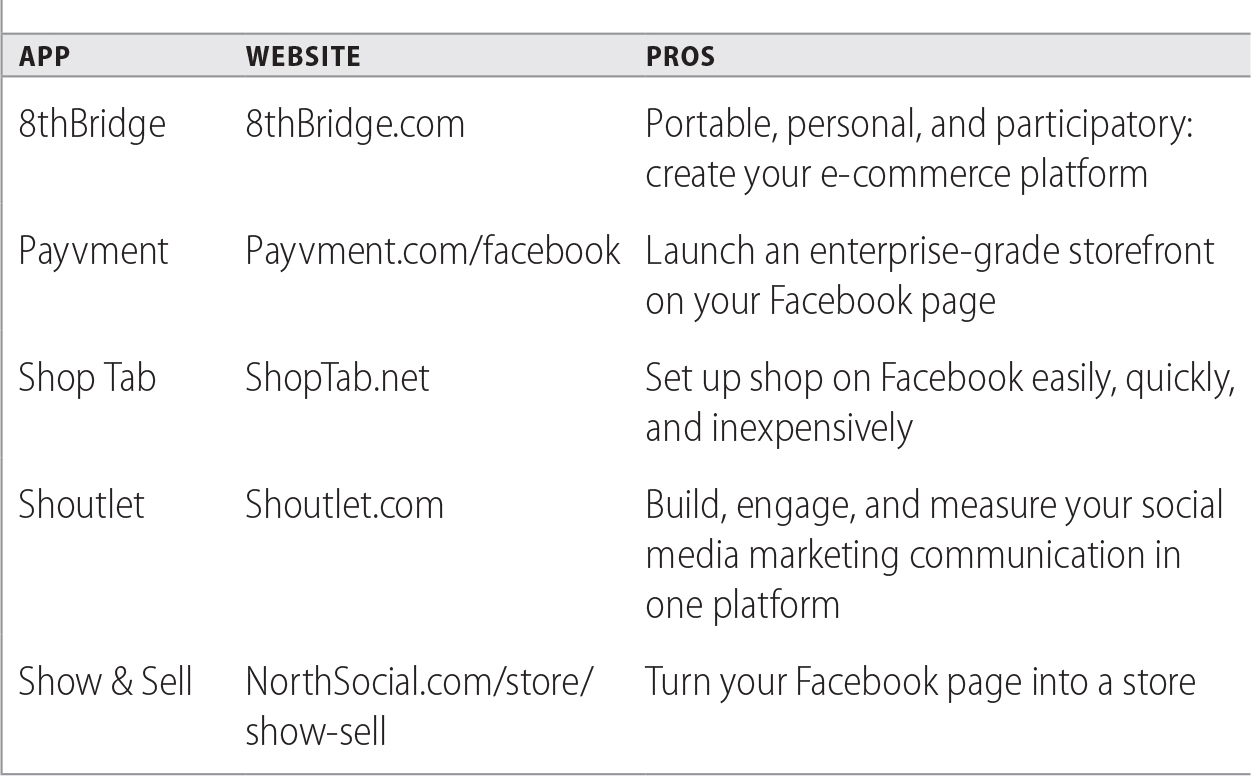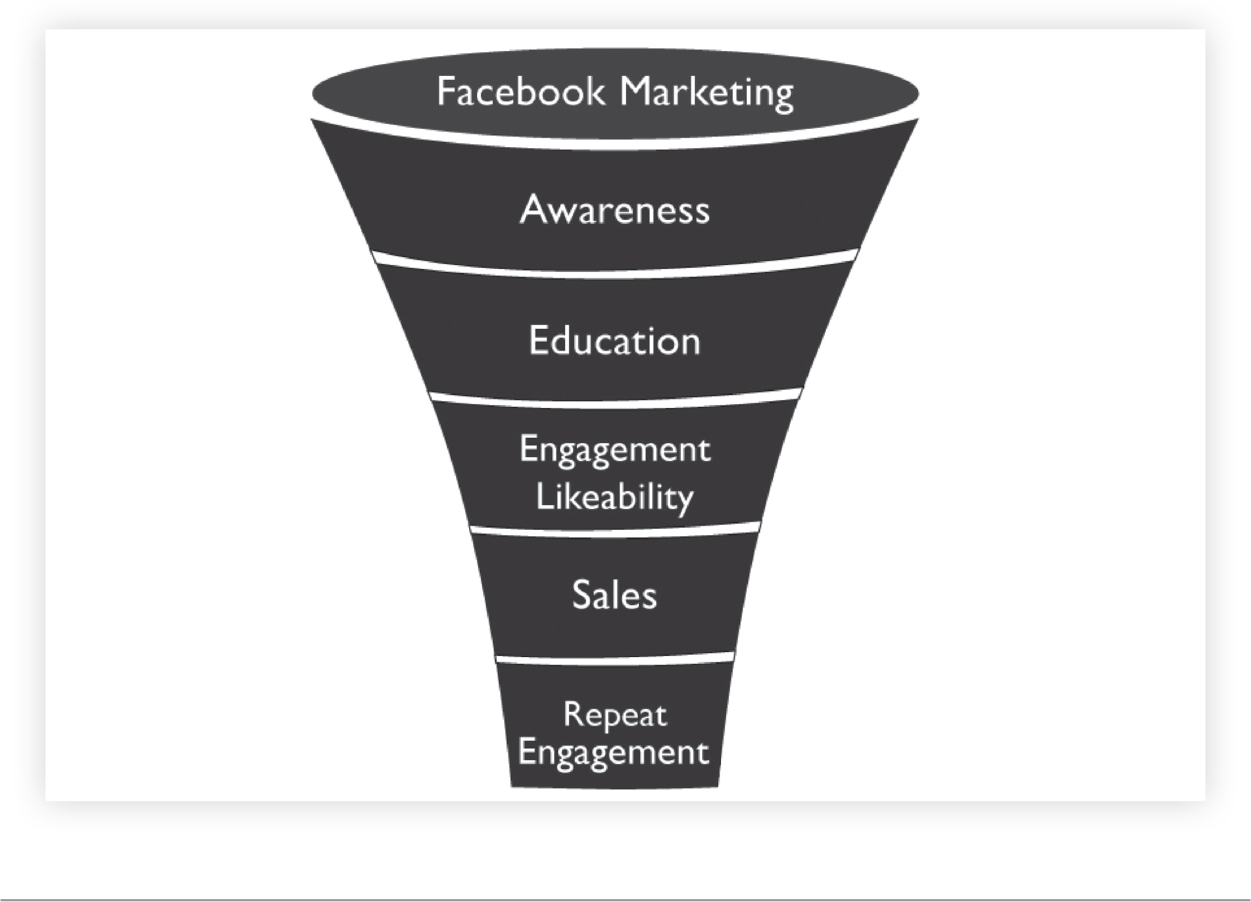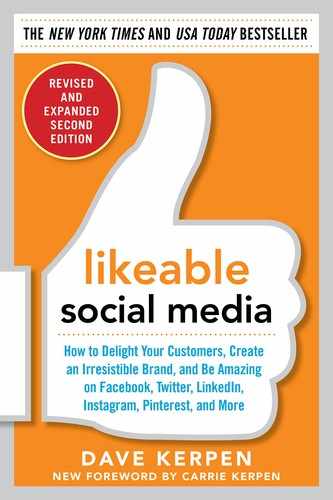
CHAPTER 18
Don’t Sell! Just Make It Easy and Compelling for Customers to Buy
It was early December 2009, and my wife and I were cuddled up on the couch, laptops in hand, as any other social-media-happy couple might be. Carrie was logged in to Facebook, checking out all the latest updates from her friends and pages she liked, when she saw one about a new scarf from the Limited “as seen on Oprah.” She thought the update was interesting enough to click, and when she did, the seemingly typical “shopping cart” appeared, with options to purchase the scarf in a wide variety of colors.
One thing that was quite different, though, from other online shopping carts she or I had clicked on before was that the cart was inside the Facebook News Feed, not on the Limited’s website. Out of curiosity alone (though the scarf was nice, and it had in fact appeared on Oprah), she clicked through the entire shopping process, eventually entering her credit card securely and purchasing the scarf without leaving Facebook. The scarf arrived at our doorstep two days later, but not before my wife had shared with hundreds of Facebook friends how easy it had been to purchase the beautiful scarf.
Carrie bought that scarf from the Limited, but it wasn’t aggressively sold to her. In one of the first business transactions involving physical items within the Facebook platform, the Limited had made the process straightforward and attractive to its thousands of fans. The Limited had created an application through which customers could browse and buy merchandise without ever leaving Facebook, had built up trust in its fan base over several months, and had the credibility of a recent mention on The Oprah Winfrey Show. All of those aspects added up, providing the Limited with the opportunity to temporarily turn a social channel into a sales channel, resulting in many thousands of dollars’ worth of immediate revenue.
SALES IS NOT A DIRTY WORD, BUT MAKE IT SIMPLE AND EASY (AND EASY DOES IT)
![]()
Facebook, Pinterest, and other social networks have grown immensely in a few short years, and, by definition, they are primarily social channels, not sales channels. However, that doesn’t mean you can’t use Facebook or Pinterest to directly sell, market, or grow your business. It does mean that the expectation most people have when they’re on Facebook or another social network is that they are there to socialize and connect with others, not to shop. In order to effectively change a social network into a sales channel, you have to make the buying process as effortless and satisfying as possible. You also have to tread carefully: if you push too hard to market or sell, you will erode the all-important trust and likeability you’ve worked hard to achieve.
The big question on every marketer’s mind is how to make money using social media. What is the real return on investment of all the time and money spent in the space? The ROI comes in many forms, of course: brand reputation and credibility, increased loyalty and frequency of purchase, increased recommendations, and decreased need for advertising, to name a few. But what about direct sales? The answer is, if you follow all of the strategies presented in Chapters 1 through 17 of this book, it’s OK, even advisable, to sell to people across social networks. Make the sales process as easy, fun, and shareable as possible, and never get too pushy.
Think about the situation this way: if you engage your prospects online, have a great product or service targeted toward the right people, and make it painless and compelling to buy whatever you’re offering, then you don’t really have to do any selling at all. Selling and marketing are usually disruptive, unwanted experiences, while buying is normally considered a fun, rewarding, and sometimes even exciting experience. So how can you create social buying opportunities instead of social sales and marketing opportunities?
There are a number of ways to directly sell your products or services through your social media networks and pages. Table 18.1 gives a few examples of Facebook applications that will help you set up shop!
TABLE 18.1 Five Facebook Apps to Sell Your Stuff

Mind the Apps
Most important, you need to focus on the technology around the buying process. The smoother it is to buy from you, the greater the percentage of your fans, followers, and users will become customers. Create or personalize a simple but highly functional Facebook, iPhone, or mobile application. Better yet, create all three. Make sure you have an easy-to-use shopping cart on your Facebook page or website. Or, for those of you who don’t have the inclination or the ability to go high tech (for example, doctors, lawyers, and accountants are unlikely to ever have a shopping cart service), simply make sure you have the best, most engaging, and friendly employees answering phones or greeting people at doors.
The more seamless the buying process, the more completed sales you’ll generate, and the more buzz you’ll create for future sales opportunities.
TWEET Doesn’t Include Selling—or Does It?
At Likeable, we suggest our clients follow a brief set of guidelines when using Twitter, based around an acronym we came up with for TWEET:
• Trust building. Build relationships.
• Wisdom. Learn from industry leaders and your customers.
• Ears open. Listen to the conversation.
• Establish your brand. Create a strong presence.
• Teach. Tell the world about what you do.
Of course, there’s nothing in this mnemonic device about selling. There’s nothing even there about marketing. But if you do a great job listening, learning, and building trust with the right people, if you establish your brand with the right fan base, and if you share what it is you and your organization do, you won’t have to sell. People will already know your product and service, and they will come to you when they are ready to buy. The less friction in the buying process, the better, and the clearer and simpler the checkout or order process, the more likely your customer will be satisfied.
Ultimately, you still have to make sure your fans and followers know what you do or sell and give the customer a buying opportunity. You could be the most engaging, transparent, responsive, and attentive company in the world, but if you never actually educate people about what you sell and, without hitting them over the head, tell them how to buy, you won’t be optimizing your social network presence.
THE FACEBOOK SALES FUNNEL DOES INCLUDE SALES
![]()
The traditional sales funnel includes awareness, intent, trigger, and then purchase. The Facebook or social media sales funnel still includes purchase—it’s just a longer path to get there (see Figure 18.1). First, you must generate awareness, and a like. Then, you’ll take the prospects through a series of interactions, engaging them and providing them with interesting, educational, or valuable content. When the customers are ready to buy, as long as you have given them a clear, simple path to purchase, the sale can be triggered.
FIGURE 18.1 Facebook Sales Funnel

But the best part of the Facebook sales funnel, as compared to the traditional sales funnel, is that it doesn’t end in one sale. The customer, still a liker, is eternally connected to you, unless he or she unlikes you. So after the sale, you can still engage with the customer, giving him or her value outside of directly purchasing your product. Staying connected with your customers on social networks after an initial sale also gives you a huge new advantage—the power of leveraging your customers’ social graph and introducing yourself passively to their friends and followers. While the sales process through Facebook is clearly a longer one, it also yields greater frequency of purchase and increased awareness of you to your customers’ networks.
USE SOCIAL NETWORKS AND INVENTORY MANAGEMENT TO SELL OUT
![]()
When you have a limited supply of inventory and a need to sell it quickly at a discount, there is no faster or more efficient way to do so than through social media. Airlines, hotels, and theaters are examples of industries that can particularly benefit from this use of social networks, especially right before the plane takes off, the rooms are booked, or the curtain rises. In general, though, any type of company or business can benefit from careful inventory management, price control, and distribution, utilizing the large social network community they’ve tapped into or helped grow.
Dell Sells on Twitter with Likeable Results
The company that has had the greatest success using Twitter to sell inventory is Dell. Through its @DellOutlet Twitter account, with more than 1.4 million followers, it has sold more than $7 million worth of refurbished computer and other electronic equipment.
How has Dell done this? When it has excess inventory of products, it deeply discounts the items, then shares a timed offer on Twitter with a link to purchase. This setup results in immediate sales but also creates word of mouth about the great deals. In turn, more Twitter users become Dell followers, and therefore, more sales opportunities are created the next time the company shares an offer.
Have you ever wondered why last-minute flights get expensive instead of cheaper? Last-minute travelers either pay an extraordinary amount to fly, or they are forced to make other travel arrangements, typically leading to lots of empty seats or half-empty flights. JetBlue was the first airline to solve this “empty seats” problem using social media. It created @JetBlueCheeps, a Twitter account dedicated solely to sharing great limited-inventory, last-minute deals on airfares. While earning $39 to $89 a ticket is not a tremendous amount of revenue for JetBlue, it’s better than flying with empty seats. Customers who can be flexible about waiting for deals on Twitter can also leverage this to the fullest degree.
Do you have inventory you could deeply discount to give away quickly? Remember, in addition to driving immediate sales, you’d gain the advantage of creating a buzz on a medium in which word spreads lightning fast. You are also likely to generate returning, and new, customers.
SODASTREAM PUTS ITS FANS FIRST—WITH GREAT RESULTS
![]()
When it came time for the at-home carbonated beverage machine company SodaStream to launch its holiday contest in 2013, the staff went to the drawing board with Likeable Media, the company’s social media agency. What SodaStream walked away with was an idea that tapped into the strongest sales generator for its organization: word of mouth and referrals. Taking the traditional marketing tactic and breathing new life into it, SodaStream encouraged fans to Fizz It Forward.
What the brand did was simple. It asked the community of over a half a million fans to tell their friends about SodaStream—and to nominate them to win their own soda-making machine. They took word of mouth and supercharged it with social media. Besides the 13,000 entries and 5 million impressions during the most crowded time of the year for brands on Facebook, the subtle nudges made not only by the brand but by the brand’s most enthusiastic fans drove over $1 million in e-commerce revenue. SodaStream never told its community to go out and buy its products. It just reminded them of a great product that was a click away.
Game On: How Disc Replay Won the Referral Game
Disc Replay is a franchise of video game and electronic stores in Indiana. In the summer of 2014, owner Alan Jackson dove head first into social media as a means to boost his marketing efforts. Disc Replay prides itself on buying and selling high-quality video games and DVDs and constantly delighting its customers. As a Likeable Local customer, Disc Replay participated in a social media referral program. Through sharing authentic content on social media and providing an exceptional experience online and off, Disc Replay landed 16 referrals through its Facebook page alone. A few “Refer a Friend” Facebook posts and approximately $30 in post boosts amounted to hundreds of dollars in video game sales and 16 new loyal customers.
BUYING OPPORTUNITIES + ENGAGING FACEBOOK UPDATES = GREATER SALES SUCCESS
![]()
If the object of the social media game is to create engaging, valuable, and likeable content and experiences for your community and if the object of the business game is to create compelling buying opportunities for your prospects, consider pairing those two objectives via one Facebook update. For instance, let’s say you’re responsible for marketing and selling shoes. An example of an engaging Facebook update to your community might be this: “What do you think the most common women’s shoe size is in the United States?” An example of a compelling sales update could be this: “Click here to enjoy 50 percent off on our newest line of women’s shoes [link].”
Remember, though, that Facebook’s News Feed algorithm is such that updates need to generate comments and likes in order to remain at the top of people’s feeds. So in order for people to even see the 50 percent discount offer, you’ll have to be at the top of people’s News Feeds. Hitting people over the head on Facebook with offers will not lead to sales, but it may very well lead to people unliking you or unsubscribing from your feed. Thus, try combining the two objectives to create a best-of-both-worlds scenario: “What do you think is the most common women’s shoe size? After you guess, click the link to find out the answer, and enjoy 50 percent off select shoes [link].”
By engaging your community, you’re creating value and optimizing for people’s Facebook feeds. Combining this engagement with a compelling offer, you give your fans a great buying opportunity, and thus you provide your company with an equally great sales opportunity.
1-800-Flowers.com Will Win Because It “Gets” Likeable, Social Sales
The company 1-800-Flowers.com won the national floral space when it became the first florist to have a memorable 1-800 phone number. It then continued to win the space by establishing a strong e-commerce platform through its website before any other flower company. Now, 1-800-Flowers.com will continue to dominate the national floral space because it understands the conjunction of e-commerce and social media.
Through third-party technology company 8thBridge, 1-800-Flowers.com was the first major retailer in the world to establish a Facebook store, in 2009. Commerce, from start to finish, can take place within the Facebook platform at Facebook.com/1800Flowers, creating an easy, compelling buying experience. More important, the company has grown a sizable fan base of more than 1 million customers on Facebook. It offers weekly promotions and contests, asks questions, and listens to the feedback it receives. The company is responsive and transparent about customer inquiries, it inspires customers’ stories, and it surprises and delights random fans. It engages!
It’s the combination of positive social media practices and easy, compelling buying opportunities that will help 1-800-Flowers.com continue to thrive in business. How can you model your practices after it, and Dell, and JetBlue? How can you create the most likeable buying process online?
KEEP ON YOUR CONSUMER CAP, THINK BUYING, NOT SELLING, AND THE SALES WILL COME
![]()
The days of push-marketing tactics are quickly coming to an end, ushering in better times for consumers everywhere. Always think the way your consumer does, create buying opportunities that you yourself would want to leverage, and make purchasing simple and easy. Be patient, and continue to provide value for your communities. Develop simple, user-friendly opportunities for customers to buy from you, wherever and whenever they choose to. The sales will come.
